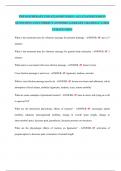PHYSIOTHERAPY END EXAM REVISION. ALL EXAM REVISION
QUESTIONS AND CORRECT ANSWERS (ALREADY GRADED A+) (2024
UPDATE) 100%
What is the treatment time for vibratory massage for postural drainage - ANSWER- up to 15
minutes
What is the treatment time for vibratory massage for general body relaxation - ANSWER- 5
minutes
What name is associated with cross-friction massage - ANSWER- James Cyriax
Cross-friction massage is used over - ANSWER- ligaments, tendons, muscles
What is cross-friction massage used to do - ANSWER- loosen scar tissue and adhesions, aid in
absorption of local edema, mobilize ligaments, tendons, scars, restore mobility
What are some examples of positional traction? - ANSWER- knee to chest, side lying on a roll
to open an IVF
What are the theoretical physiologic effects of traction? - ANSWER- encourages spinal
mobility, enhances intersegmental mobility, change in overall spine length, change in
intervertebral space, decrease pain, parasthesia, decrease pressure on structures
What are the physiologic effects of traction on ligaments? - ANSWER- activation of
proprioceptors to decrease pain, restoration of normal length
,What are the physiologic effects of traction on discs? - ANSWER- decreased discal pressure,
imbibition of disc for proper nutrition, unstable reduction of herniation
What are the physiologic effects of traction on facet joints? - ANSWER- increases separation,
decompression, proprioceptive discharge may decrease pain
What are the physiologic effects of traction on musculature? - ANSWER- stretching, improve
blood flow, activation of proprioceptors
What are the physiologic effects of traction on nerves? - ANSWER- decrease compression,
improved blood supply to nerve tissue, decrease of inflammatory products
What is more tolerable to the patient- intermittent or sustained traction? - ANSWER-
intermittent, tolerable both at higher forces and for longer duration
Which allows more decompression of disc- intermittent or sustained traction? - ANSWER-
sustained
Which has shorter treatment times- intermittent or sustained traction? - ANSWER- intermittent
What is the traction phase for short phase intermittent traction? - ANSWER- less than 10
seconds
What is the traction phase for long phase intermittent traction? - ANSWER- more than 10
seconds
,What are the indications for spinal traction? - ANSWER- disc protrusion, disc
herniation/prolapse, nerve root impingement, spondylolisthesis, joint hypomobility, arthritis
conditions of facet joints, mechanically produced muscle spasm, joint pain, scoliosis
What are some contraindications for spinal traction? - ANSWER- fractures, joint instability or
hypermobility, tumors, osteoporosis and osteomalacia, bone and joint infections, osteo and
rheumatoid arthritis, vertebral artery occlucion, pregnancy (cervical is ok), hiatal hernia and
abdominal hernia, displaced disc fragment and cord compression.
Interferential - ANSWER- Two low amplitude alternating currents with one usually being at
4000 Hz and one at 4100Hz. A beat current is produced with a frequency equal to the difference
between the two applied currents. The amplitude is equal to the sum of the amplitudes of the two
applied currents;
sinusoidal AC - 2 currents are arranged to cross and result in a "beat" frequency as the difference
of the two currents - very comfortable
Pulsed Current - ANSWER- The flow of the current starts and stops. May be monophasic or
biphasic, Electrical current delivered discontinuously; periods of pulsing followed by periods
where no current is flowing (usually off longer that it is on); May be unidirectional or bidirectional
Phase duration - ANSWER- How long each phase lasts (microseconds).
Pulse frequences - ANSWER- Number of pulses per second. (Hz or pps).
Amplitude (intensity) - ANSWER- Rate of flow (current) or voltage (mA, volts).
, modulation - ANSWER- Variation in one of the current parameters (pulse duration, pulse
frequency or Amplitude).
wave form
Current intensity/amplitude
Pulse Duration
Pulse Rate - ANSWER- Total current is changed by...
Law of Dubois Reymond - ANSWER- Determines whether there will be a physiological
response when a current is applied.
Phases of healing - ANSWER- - inflammation
- repair
- remodeling
what is the purpose of inflammation - ANSWER- - immobilize the area
- defend against intruders
- remove damaged tissue and debris
signs of inflammation - ANSWER- celsus
- heat
- redness
- pain




